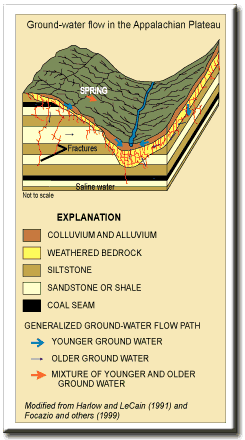|
The Appalachian
Plateaus province encompasses approximately 1,600 mi2
and is characterized by a well-dissected mountainous landscape with
dendritic drainage formed on almost flat-lying to gently folded Paleozoic sedimentary rocks
(Trapp and Horn, 1997). Elevations
range from about 1,000 ft above sea level to over 4,000 ft above sea level
on High Knob. The eastern edge
of the province is the Cumberland Escarpment, which coincides with the
Appalachian structural front where the westernmost fault of the Valley and
Ridge province reaches the surface. A
thin mantle of weathered material covers the bedrock, which is composed of
relatively undeformed sedimentary rocks--sandstone, shale, and limestone
(Powell and Larson, 1985). The most characteristic rock type is coal
that occurs as beds and seams and is commonly fractured (cleats) along joint
systems (Harlow and LeCain,1991). Vertical, stress-relief fractures
are another prominent feature in this province (Wyrick and Borchers, 1981).
formed on almost flat-lying to gently folded Paleozoic sedimentary rocks
(Trapp and Horn, 1997). Elevations
range from about 1,000 ft above sea level to over 4,000 ft above sea level
on High Knob. The eastern edge
of the province is the Cumberland Escarpment, which coincides with the
Appalachian structural front where the westernmost fault of the Valley and
Ridge province reaches the surface. A
thin mantle of weathered material covers the bedrock, which is composed of
relatively undeformed sedimentary rocks--sandstone, shale, and limestone
(Powell and Larson, 1985). The most characteristic rock type is coal
that occurs as beds and seams and is commonly fractured (cleats) along joint
systems (Harlow and LeCain,1991). Vertical, stress-relief fractures
are another prominent feature in this province (Wyrick and Borchers, 1981).
Ground-Water Flow
Ground-water flow occurs in (1) the regolith (unconsolidated alluvium,
colluvium, and saprolite) and (2) along fractures and joints in the
bedrock. Recharge to the fractured rock aquifers is somewhat limited
by the highly dissected, steep terrain and relatively impermeable
bedrock. Ground water moves steplike along the more permeable vertical
fractures and sub-horizontal coal and sandstone beds (Harlow and LeCain,
1991; Trapp and Horn, 1997).
Generally, apparent ground-water ages can be
relatively old; however, downward movement of water along the vertical
fractures can be rapid and enhanced by pumpage.
|
|
References
Focazio,
M.J., Plummer, L.N., Böhlke, J.K., Busenberg, Eurybiades, Bachman, L.J.,
and Powars, D.S., 1998, Preliminary
estimates of residence times and apparent ages of ground water in the
Chesapeake Bay Watershed, and water-quality data from a survey of springs:
U.S. Geological Survey Water-Resources Investigations Report 97-4225, 75 p.
Harlow,
G.E., Jr., and LeCain, G.D., 1991, Hydraulic characteristics of, and
ground-water flow in, coal-bearing rocks of southwestern Virginia:
U.S. Geological Survey Water-Supply Paper 2388, 36 p
Powell, J.D., and Larson, J.D., 1985,
Relation between ground-water quality and mineralogy in the coal-producing
Norton Formation of Buchanan County, Virginia: U.S. Geological Survey
Water-Supply Paper 2274, 30 p.
Trapp, Henry, Jr., and Horn, M.A., 1997,
Ground Water Atlas of the United States: Delaware, Maryland, New Jersey,
North Carolina, Pennsylvania, Virginia, West Virginia: U.S. Geological
Survey Hydrologic Atlas HA 730-L, p. .
Wyrick, G.G., and Borchers, J.W., 1981, Hydrologic effects of stress-relief fracturing in an Appalachian valley: U.S. Geological Survey
Water-Supply Paper 2177, 51 p.
|




